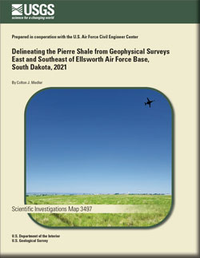Delineating the Pierre Shale from Geophysical Surveys East and Southeast of Ellsworth Air Force Base, South Dakota, 2021
Links
- Document: Report (8.72 MB pdf) , HTML , XML
- Sheets:
- Sheet 1 (16.5 MB pdf) —Depth to Pierre Shale from Electrical Resistivity Tomography Inversion and Horizontal-to-Vertical Spectral Ratio Results for Transects 1A, 1C, 1D, 4F Alternate 1, and 4F Alternate 2, Ellsworth Air Force Base, South Dakota
- Sheet 2 (14.9 MB pdf) —Depth to Pierre Shale from Electrical Resistivity Tomography Inversion and Horizontal-to-Vertical Spectral Ratio Results for Transects 2, 3A, 3B, 3D, 3E, and 3F, Ellsworth Air Force Base, South Dakota
- Sheet 3 (16.7 MB pdf) —Depth to Pierre Shale from Electrical Resistivity Tomography Inversion and Horizontal-to-Vertical Spectral Ratio Results for Transects 4A, 4B, 4D, 4E, 4FD3, 4FD4, 4FD5, 4G, 4H, and 5, Ellsworth Air Force Base, South Dakota
- Data Release: USGS data release - Electrical resistivity tomography (ERT) and horizontal-to-vertical spectral ratio (HVSR) data collected East and Southeast of Ellsworth Air Force Base, South Dakota, in 2021
- Download citation as: RIS | Dublin Core
Abstract
The U.S. Geological Survey, in cooperation with the U.S. Air Force Civil Engineer Center, used surface-geophysical methods to delineate the top of Cretaceous Pierre Shale along survey transects in selected areas east and southeast of Ellsworth Air Force Base, South Dakota, from April to September 2021. Two complementary geophysical methods—electrical resistivity and passive seismic—were used along 21 colocated transect surveys east and southeast of Ellsworth Air Force Base for a total of 24.7 line-kilometers. Electrical resistivity results were analyzed using EarthImager2D electrical resistivity tomography processing and inversion software. Two-dimensional earth models showing the electrical properties of the subsurface were evaluated by directly comparing the high and low subsurface resistivity values to a surficial-geologic map and nearby wells with drillers logs. Passive seismic data were analyzed using the horizontal-to-vertical spectral ratio method to determine the depth to the Cretaceous Pierre Shale at each survey point. The depth to the Pierre Shale along the transects ranged from 0.0 to about 19.8 meters, and the mean and median depths were about 6.1 and 5.6 meters, respectively. The elevation of the Pierre Shale and thickness of unconsolidated deposits generally increased with land-surface elevation from south to north; however, some transects displayed topographically high and low areas that did not correlate with land-surface topography.
Suggested Citation
Medler, C.J., 2022, Delineating the Pierre Shale from geophysical surveys east and southeast of Ellsworth Air Force Base, South Dakota, 2021: U.S. Geological Survey Scientific Investigations Map 3497, 3 sheets, 15-p. pamphlet, https://doi.org/10.3133/sim3497.
ISSN: 2329-132X (online)
Study Area
Table of Contents
- Acknowledgments
- Abstract
- Introduction
- Geophysical Surveying Methods
- Geophysical Survey Results
- Summary
- References Cited
| Publication type | Report |
|---|---|
| Publication Subtype | USGS Numbered Series |
| Title | Delineating the Pierre Shale from geophysical surveys east and southeast of Ellsworth Air Force Base, South Dakota, 2021 |
| Series title | Scientific Investigations Map |
| Series number | 3497 |
| DOI | 10.3133/sim3497 |
| Publication Date | December 19, 2022 |
| Year Published | 2022 |
| Language | English |
| Publisher | U.S. Geological Survey |
| Publisher location | Reston, VA |
| Contributing office(s) | Dakota Water Science Center |
| Description | Report: vi, 15 p.; 3 Sheets: 64.00 × 53.33 inches or smaller; Data Release |
| Country | United States |
| State | South Dakota |
| Online Only (Y/N) | Y |
| Additional Online Files (Y/N) | Y |


